Honda FCX Clarity
The Honda FCX Clarity was rolled out at the 2007 Los Angeles Auto Show and will be available as a lease vehicle to select customers in the summer of 2008. The lease price will be $600 per month for 3 years with Honda paying for the maintenance and collision insurance and the customer paying for the hydrogen gas.
|
The Honda FCX Clarity carries new bumpers and smaller wheels, which distinguish it from the 2005 prototype in outward appearances.
|
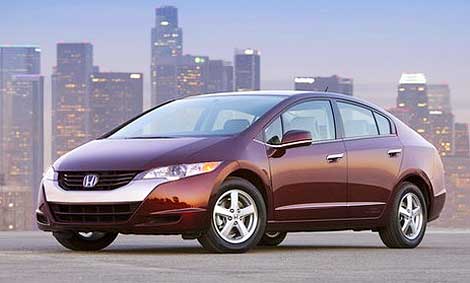 Honda FCX Clarity |
The Honda FCX Clarity is powered by a 100 kw V-Flow fuel cell stack, a lithium-ion battery pack (50-percent smaller than on the current FCX), a 95 kw electric motor, and 5,000 psi compressed hydrogen gas storage tank that yields a range of 270 miles.
Once the FCX Clarity’s mileage is certified by the EPA it is expected to come in at 68 mpge (miles per gallon equivalent). Honda has reduced the size of the fuel cell powertrain by 400 lbs and the fuel cell itself is about the size of a desktop computer sans monitor. The fuel cell stack has also been improved so that it can start in -22 degrees F.
When the Honda FCX Clarity rolls out for lease in 2008, it will be available to customers in Southern California only. One of the restrictions of the rollout will be that customers live near one of the active hydrogen fueling stations in Torrance, Santa Monica or Irvine.
|
Since the station at Torrance is at the Honda R&D facility, the Honda representatives that I have talked with are unsure where or not customers will be charged for filling up at this station, since it may not be set up to accept credit cards as the other stations are. Honda has stated that another possibility for refueling is a station that Shell Hydrogen plans to build in the near future.
|
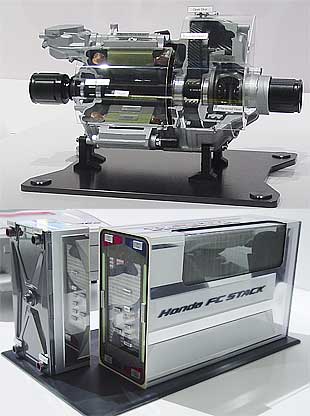 |
Top Photo: The FCX Clarity electric motor shows off its hollow construction with drive shaft passing through the center. This allows motor and gearbox to be combined into one unit.
Bottom Photo: The FCX Clarity fuel cell is much more compact than the last generation version and is only about the size of a desktop computer.
Honda is also committed to servicing the Honda FCX Clarity in a similar fashion to other vehicles. When the FCX Clarity needs servicing, the driver will take the car to the local Honda dealership as would anyone else with this brand of automobile. From there, the Clarity will go to a special service center that Honda is now building in the Los Angeles area in support of these fuel cell vehicles. When the FCX Clarity has been repaired, the customer picks the vehicle up from the dealer.
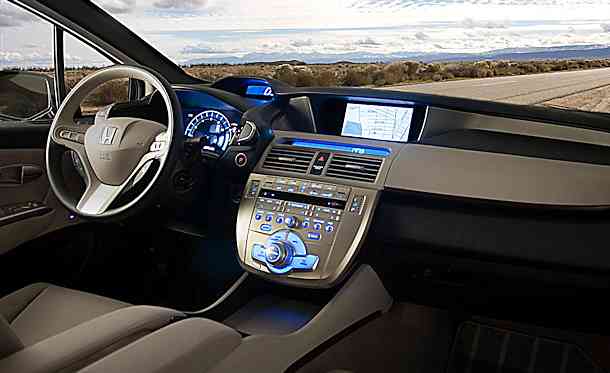
The interior of the FCX Clarity is also eco-friendly. Upholstery on the seats and door linings are made from Honda’s plant-based Bio-Fabric that is durable and helps to reduce CO2 emissions.
Honda is keeping tight-lipped on just how many FCX Clarity vehicles will be rolling out. They are now saying the number will be in the 10’s but less than 100. More information is expected in this area by summer of 2008.
The FCX Clarity has been certified to meet all safety and emissions standards (CARB and EPA) and is qualified for a $12,000 tax credit as well. Newer safety features of the Honda FCX Clarity include collision monitoring and backup camera plus the vehicle also offers real time traffic reports incorporated into its navigation system.
In November 2007, Honda also announced the first customer to drive the FCX Clarity is Terry Tamminen. Mr. Tamminen is the former Secretary of the California EPA and has had an active roll in creating California’s Hydrogen Highway system. In February 2008, Honda retracted this statement saying that Mr. Tamminen is driving a Model Year 2006 FCX.
Like the home hydrogen fueling station that was paired with the 2005 FCX prototype, Honda is introducing its Home Energy Station IV as well. This home hydrogen fueling station is 75-percent smaller than the first station and reduces CO2 emissions by 30-percent over the old station. The Home Energy Station IV uses steam reforming of natural gas to create hydrogen from both the steam and natural gas with equal parts coming from both.
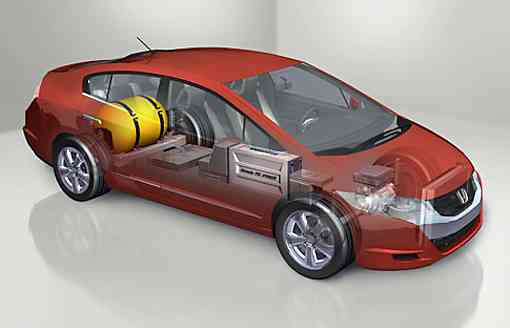
The Last Generation – 2005 Honda FCX
The 2005 Honda FCX hydrogen car is a second-generation H2 car with many improvements over the 2004 and 2002 FCX hydrogen cars. Like the 2004 edition, the 2005 Honda FCX h2 car has been certified by both the United States Environmental Protection Agency (EPA) and the California Air Resources Board (CARB) for commercial use. The 2005 edition also achieves 20-percent greater fuel economy (62/51 mpkg vs. 51/46 mpkg) and a 33-percent gain in horsepower (107 bhp) over its 2004 counterpart (80 bhp).
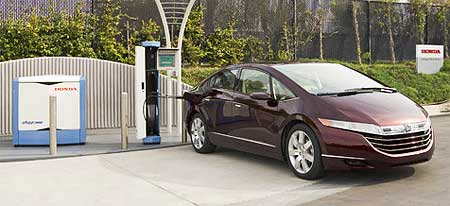 Honda FCX Hydrogen Concept Car and Home Energy Station III in Torrance, California |
Honda’s hydrogen fuel cell FCX cars have been used as fleet vehicles since 2002 by such agencies as City of Los Angeles, City of San Francisco and California’s South Coast Air Quality Management District, which make daily use of the vehicles.
2 comments on “Honda FCX Clarity”
Leave a Reply
You must be logged in to post a comment.
Can I produce my own hydrogen fuel at home or office utilizing efficient solar panels..compatable with an electrolyzer..H20 purification syst..and electrical control panel that ca, monitor,control transform e.power into enough energy to create two products entirely sustainably.(.pure hydrogen and oxygen.)
Why arent more homes / business’ in the S/W producing their own fuel and running entire households, bussiness’ and communities w/ solar, electrolisys and hydrogen fuel cells??? Is it too expensive??? unavailable?? too dangerous?? wish i could comprehend and contribute to this inevitable sustainable tecnology solution transition that seems has been stategically slowed precluded by big oil/energy co’s.. this tech.has been around since apprx. 1850ish..any n all insight/reply/wizdom..greatly appreciated
Hi Joseph, and thanks for your post! Yes, having a solar-hydrogen home is a bit expensive now (but it is safe). It has been getting cheaper over the years. I’ve been told that compressing the hydrogen in a safe and cost-effective manner for a fuel cell vehicle is still a challege for a home setting. Here is more info about a company doing this very thing though and a recent installation in New Jersey: http://hydrogenhouseproject.org/